Beyond teaching the technique of how I work fabric collage, is giving my students guidance for a particular project they’re working on. This individualized feedback is important as it sets a course for the student to follow in order the make progress. Their success may be dependent on this feedback.
As is the case in many aspects of life, how something is said can be as important as what is said. Exposing work to a critique, even though one is in a class to learn such things, can make students feel exposed and vulnerable. Keeping my student confident and upbeat, while giving them meaningful feedback, is the goal. It’s important to deliver a critique in the proper way.
When a student is asking for feedback, it makes it easier and more useful (often) when they have a specific concern or question. This allows me to focus in on an area that the student already knows needs to be adjusted.
Then it’s up to the student to accept—or reject—the feedback. In either case, having a mindset that is open to receiving feedback is critical.
Asking for feedback, giving feedback, and taking feedback: the following examples—borrowed from a previous Patreon private Facebook page—demonstrate each phase of the critique.
[Note: I have since switched to giving feedback to Patreon members through a monthly Show and Share Zoom Meeting. Click here for more information].
* * *
Asking for Feedback
In the post below Judy Crotts asked for feedback in some very specific areas for her in-progress quilt above: the paws, the background, and so on. She even suggested some changes of her own. This gave a great starting point to give her my critique.
I think it’s always a good thing to start with the positive. As the old song says, “A spoonful of sugar makes the medicine go down…in the most delightful way.” It’s important that comments be specific and sincere. Then I move on to address specific concerns.
On the other hand, a student’s request might be more open-ended. They might ask: “What do you think?” or “Any ideas?”, which invites a more generalized response. If they ask specific questions I can give more specific feedback.
Again, before delivering the ways I would change a piece, I like to point out what is already working. If a student is working on a portrait of a dog, let’s say, after noting how cute the portrait is (everyone knows their pet is the cutest ever), I might point out how a difficult portion of the piece was successfully dealt with: the dog’s nose, for example.
One type of response does not fit all situations. I try to take into account the individual’s fabric collage experience, progress, and goals when answering questions and giving a critique. The point is: the clearer a question is in the mind of a student, the more specific an answer can be.
* * *
Giving Feedback
Below is the tracing Mary Hammond made of her dog, Mac, in preparation for her fabric collage quilt. This extended example takes us from the very beginning of this collage to when it is fairly far along. It’s sometimes helpful to catch students at the beginning of a project so any drawing issues can be corrected prior to getting into their fabric. Once fabric pieces start getting placed, it gets a little harder to see what may need to be changed underneath.
I can tell when someone has put a lot of effort into their work, so why not start with that? I don’t expect things to be “perfect,” even from myself, but it’s nice to know when you’re on the right track. I’ve seen so many dog noses in my students’ subjects that it was easy for me to pick out what needed to change there.
Giving Mary a solution to an issue with the dog tags is better than just pointing out that they don’t look right. And it’s never a bad time to say “You can do it” to anyone.
Mary’s next step was choosing fabrics. I sometimes suggest students lay out their fabrics just as she has here, according to color and value, so I point that out so Mary knows she’s on the right track before I suggesting any changes.
Mary has two issues here: she’s lacking in the mid-range values and she’s using solids instead of patterned fabrics. I break these issues down into steps. Giving a step-by-step list is a helpful way of organizing the changes I’m suggesting.
In the post below, Mac has moved along to the point where Mary can start asking about specific areas of concern for her.
In my comment below I wish I could have been more succinct. Being brief is often better than belaboring a point, but this was such an important idea that I needed to go on at length. I tried to be clear, but in case I wasn’t, I ended by by asking, in essence, if she understood: “Let me know if I need to try again!”
Admitting that I am struggling to make myself and my feedback understood helps make the student and I part of team. It’s not me pointing out what’s “wrong” and her failing to understand. We’re working on it together, trying to communicate back and forth to achieve success.
* * *
Taking Feedback
In asking for feedback, it’s also important how it’s accepted. A critique is about a particular aspect of one’s work—and that’s all. I make my suggestions, and occasionally have students who resist them. Opinions are to be considered, mulled over, and followed if it resonates with that particular person, for that particular subject.
When Mary McKay asked me to weigh in on her drawing for the design of her alpaca, she responded positively even though it meant starting over.
As you can see, Mary did a very nice job taking in my suggestions for how she might improve her drawing, and her follow-up drawing is much clearer.
* * *
Faith McLeod’s portrait of her friend Bessie and her cow (below) was already progressing nicely when she reached out for suggestions on the color of Bessie’s sweater. I was worried that Faith’s thought about denim would blend with the blues of the cow, so I suggested a complementary color.
Faith, however, had a very good reason for not following my suggestion (and note how she began with a positive in her reply!). Since her friend Bessie hated orange, Faith went with green. I appreciate that she didn’t blindly follow my suggestion, and came to a decision that made sense for her and for the quilt.
* * *
I hope you can take what I have learned about giving and receiving feedback and apply them to when you are helping someone or being helped. Let me leave you with some “rules of thumb”.
- Start with the positive.
- Ask questions, such as: How do you think ___ is working? What were you trying to accomplish when you did ___? What concerns you about the piece?
- Instead of saying, “I don’t like ___,” say, “For me ___ isn’t working yet, how about for you?” On the other hand say, “I like ___” often. Make your praise specific and sincere.
- Offer solutions if you can, rather than just pointing out problems.
- If you have reason to (gently) reject someone’s feedback, don’t be afraid to make your own decision.
And, most importantly:
- Apply the golden rule: be nice.
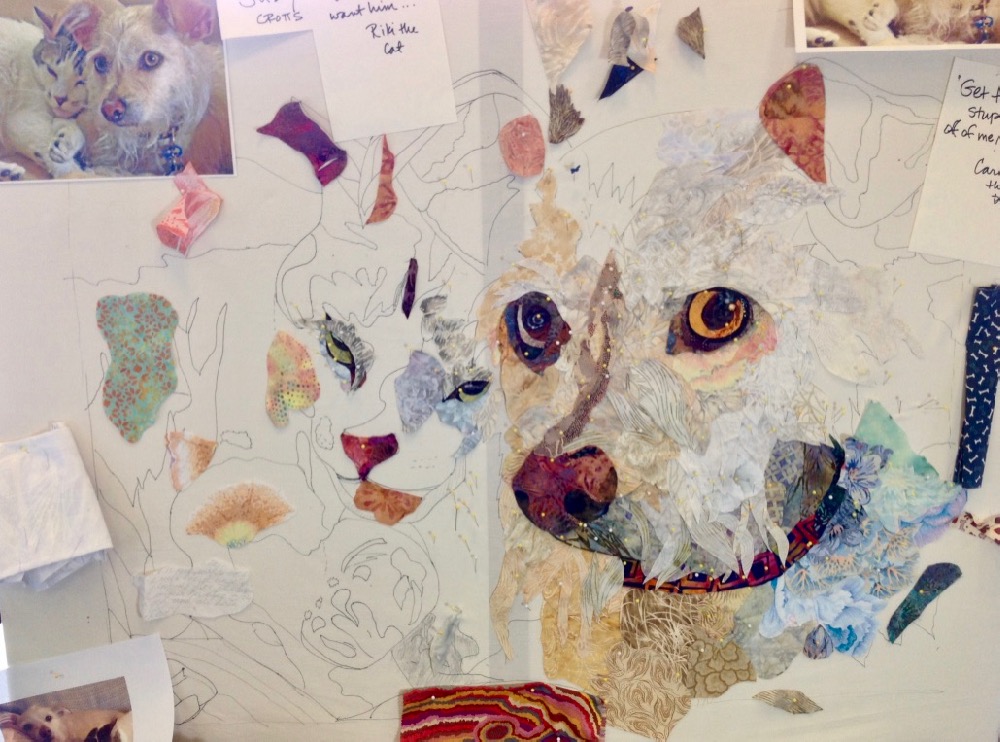
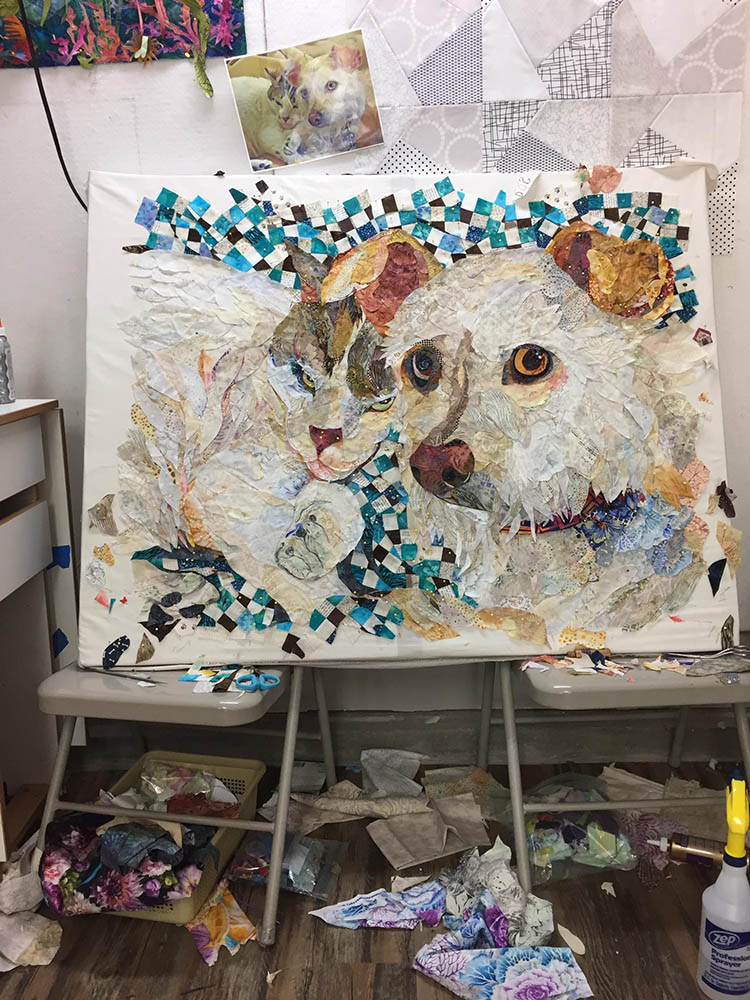
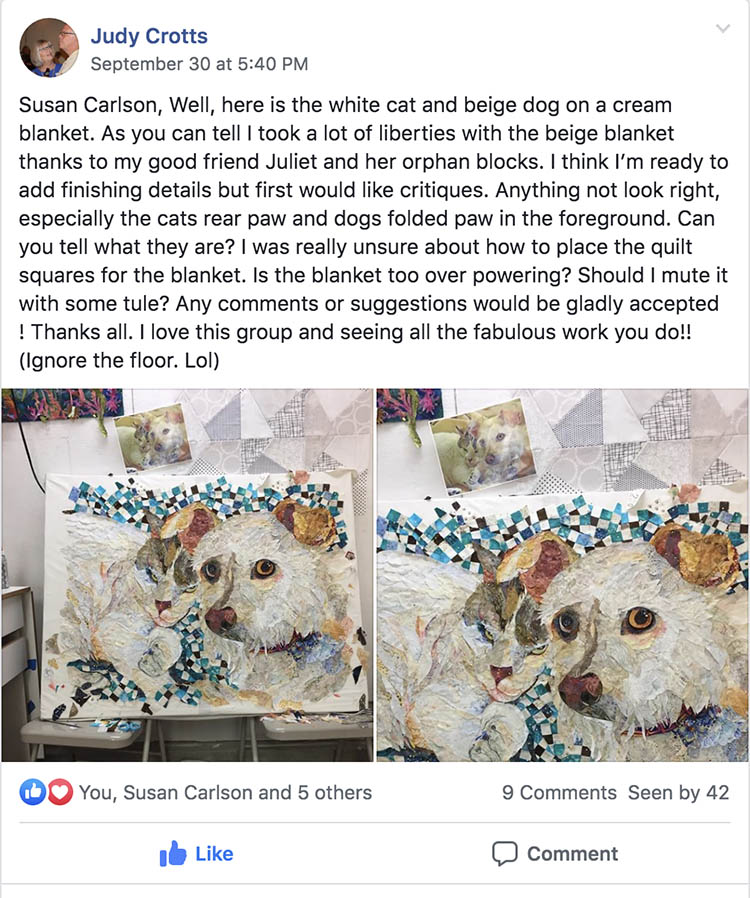
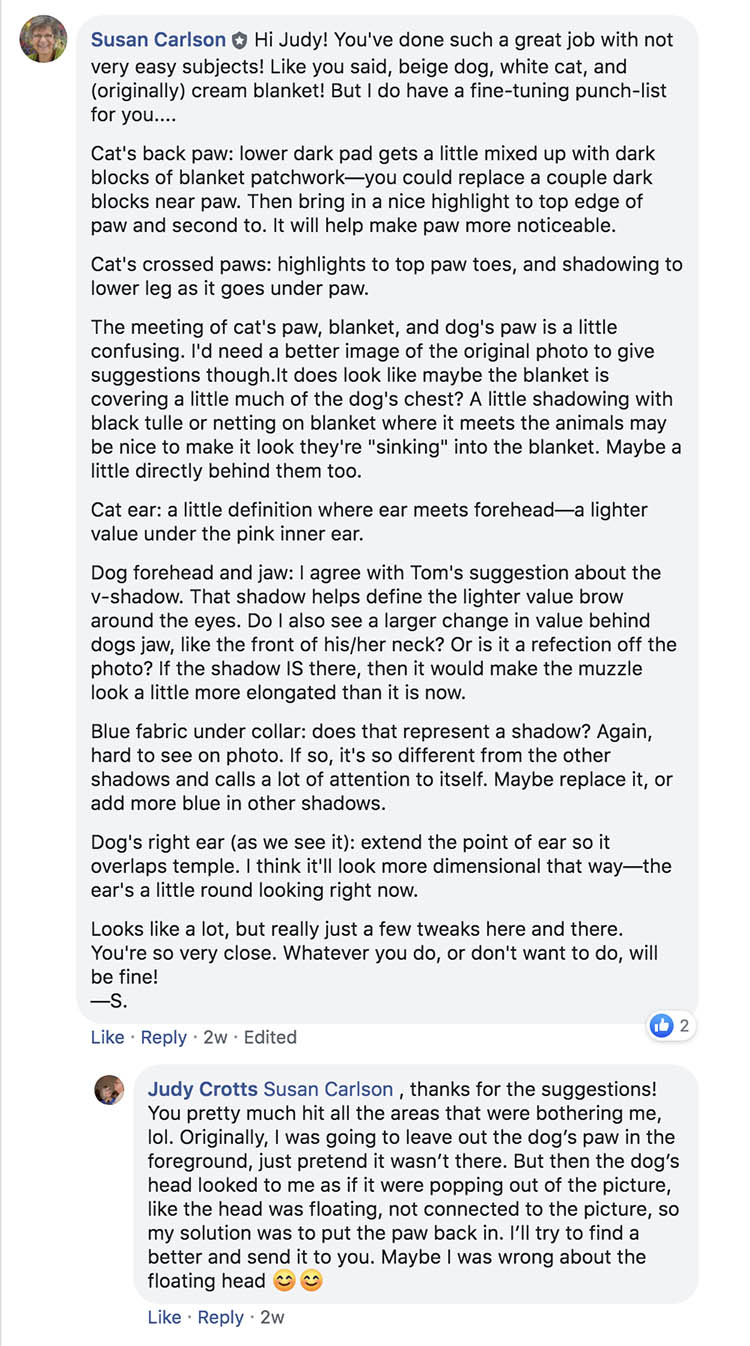

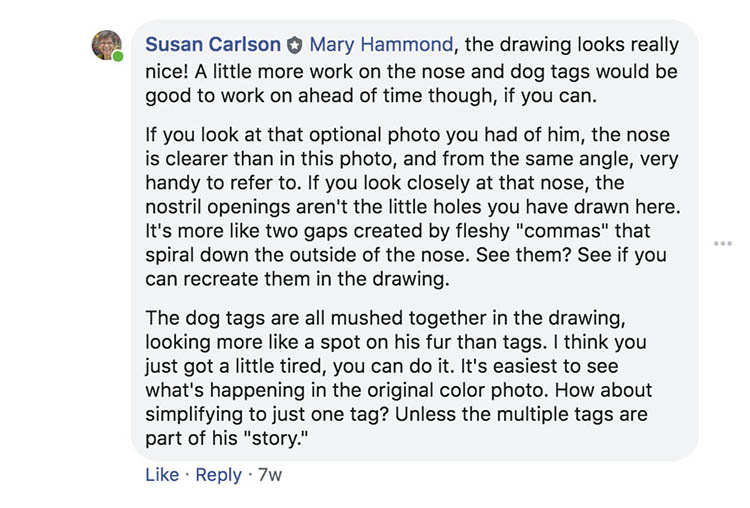
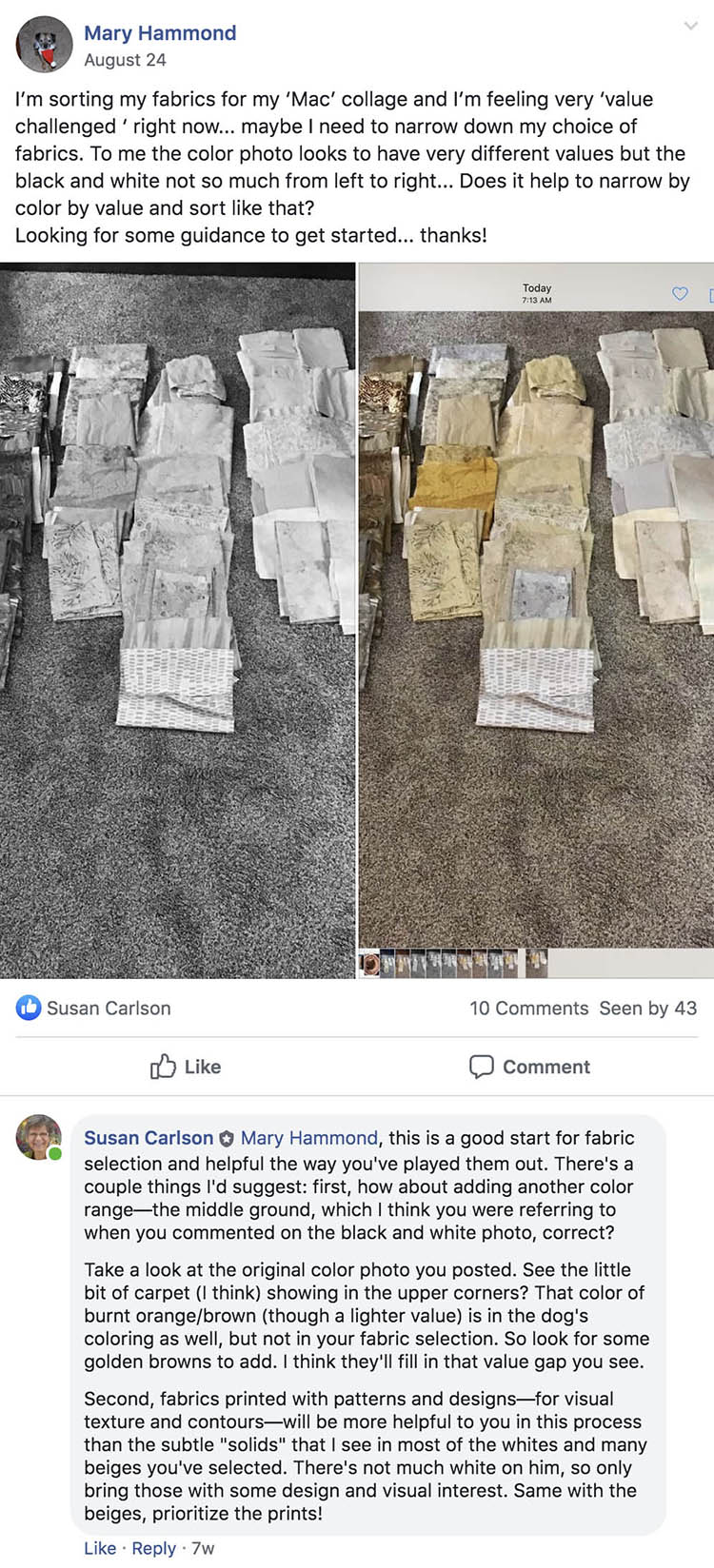

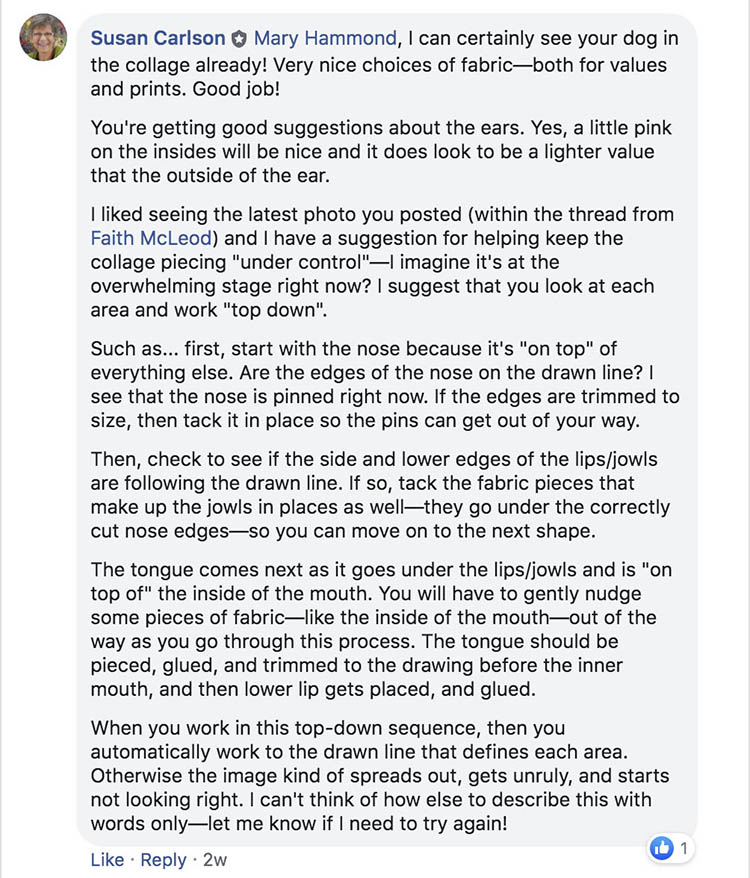
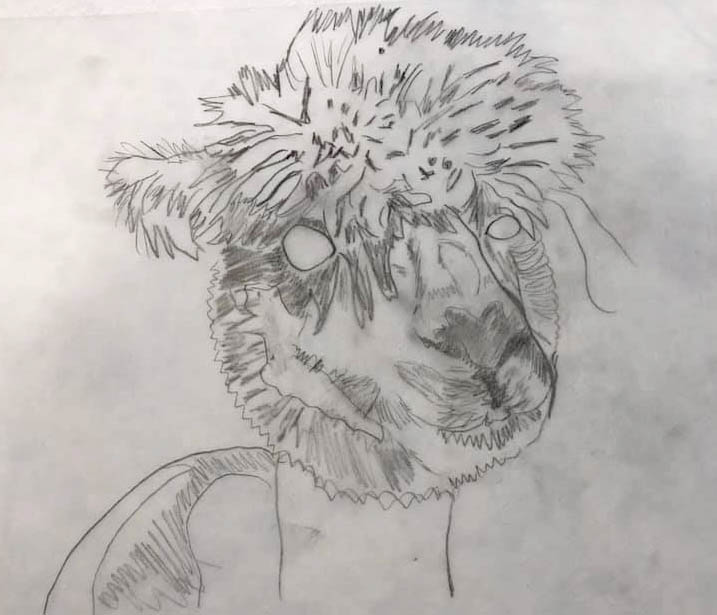
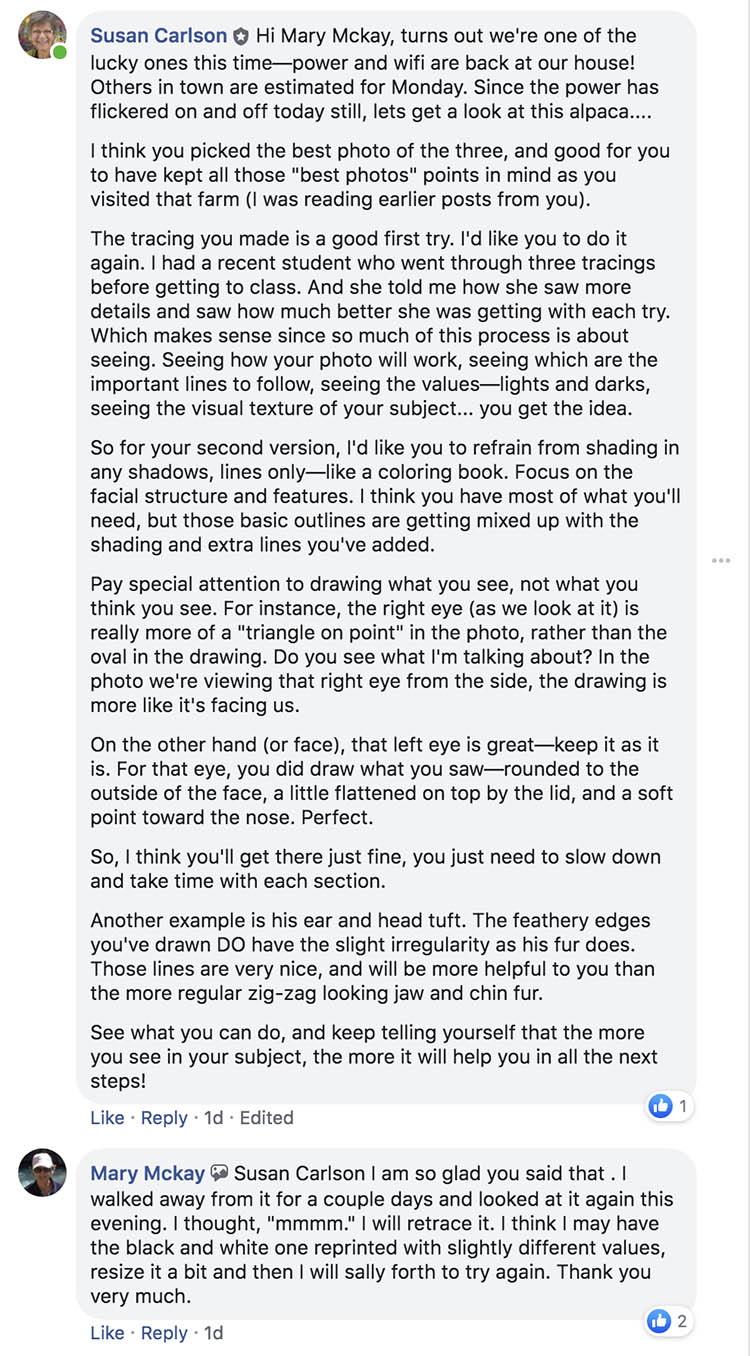
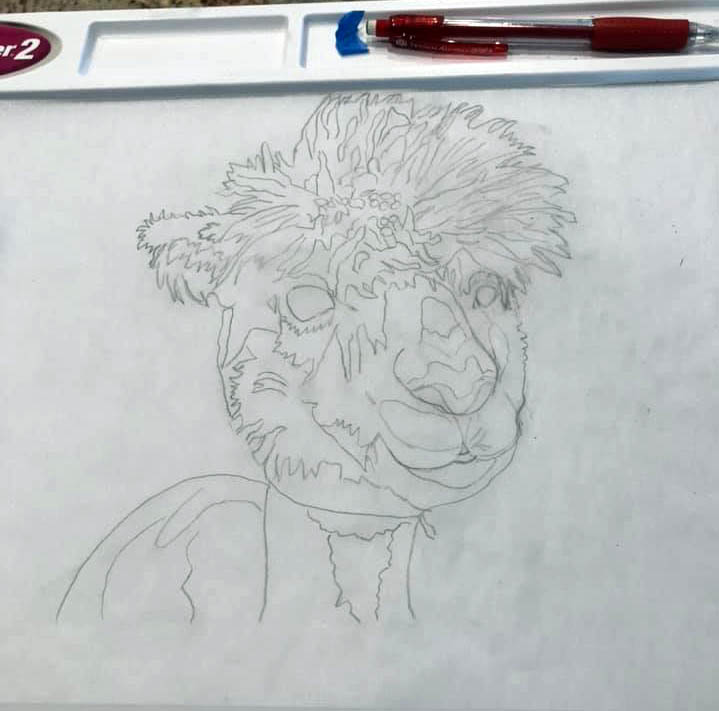
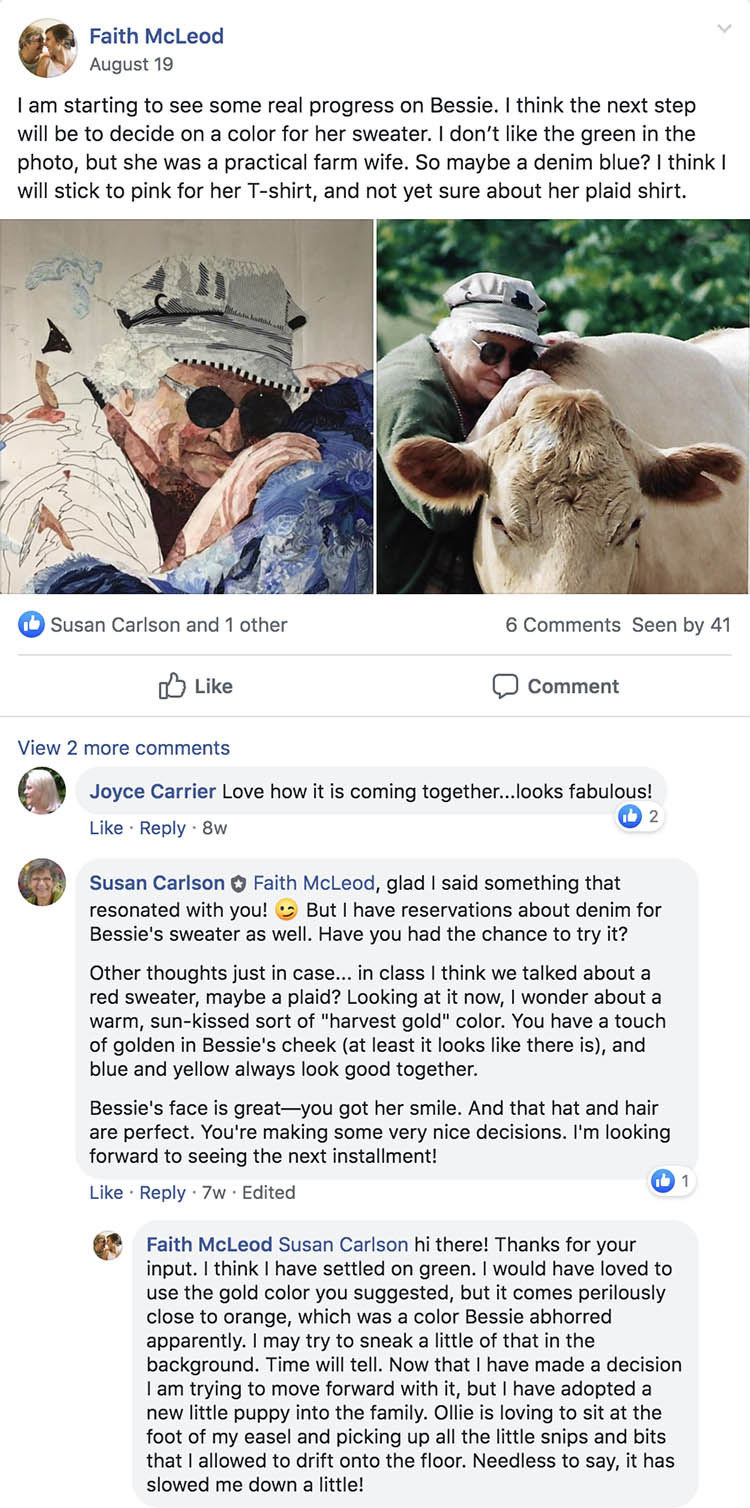
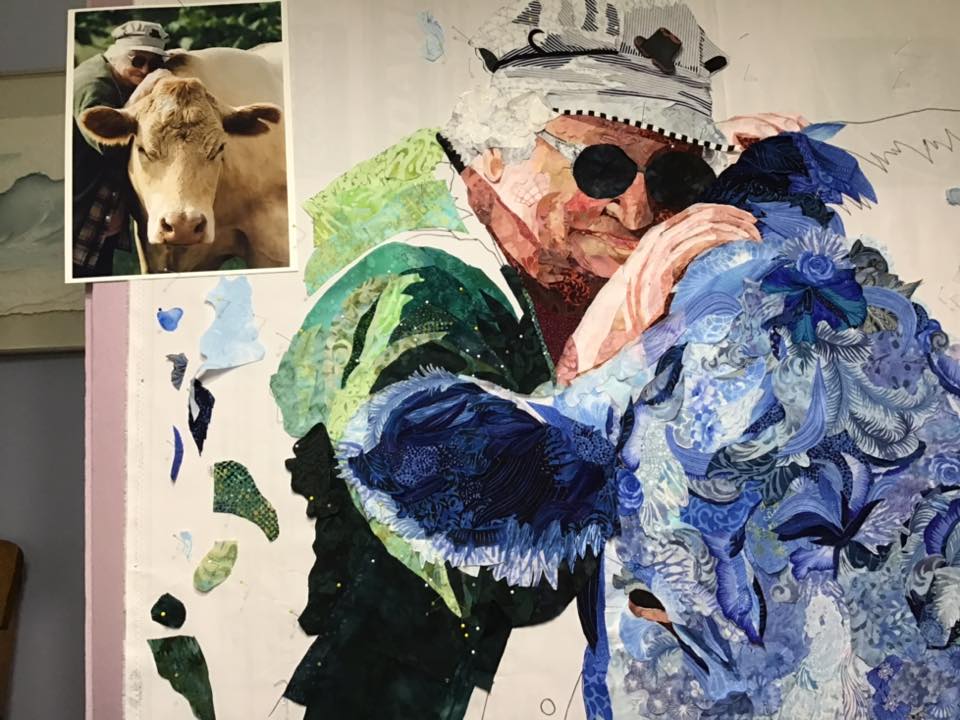
I really like your speaking points and I think this way of giving ideas would work in all aspects of life thank you and reading your answers was a lot of help I had started a wolf and gave up now I see that maybe I need to go back to the drawing board so to speak
Susan, I can still hear your voice in my head as I go about working on my donkeys, Romeo and Juliet, and I can’t tell you how helpful it is to me! 🙂
Great guidance for critique. We are just starting an art quilt critique group and I am going to suggest this article as great reading to prepare for our group. It can be a really tough ‘assignment’ to get correct, your guidance will help greatly. Thank you.
Thank you for covering the subject of asking for and receiving constructive feedback! In my experience, suggestions were offered in such a positive and encouraging fashion that it was always a pleasant experience–l was left celebrating what WAS working and feeling inspired to work on the “trouble” areas!
Makes so much more sense to ask specific questions. I tend to just say what do you think and I should not assume that the things that are bothering me, everyone else will see.
I know now that I have left the door open too far, will be more specific in the future.
This was a very helpful blog and the thread of conversation went so smoothly when the questions/concerns were outlined.
Thank you ðŸ™
I love this week’s post! I have not taken a huge number of quilting/collage classes. I am touched at your ability to see a student’s project through THEIR eyes at the same time you are guiding them in your techniques. This does not happen with many teachers! I will revisit this post again.
You are such a great coach and teacher. I have to agree with a sentiment expressed by another commenter—- your advice is applicable to most aspects of life, not just fabric collage. We all welcome encouragement.
Hi Susan. Thank you for writing such an insightful blog. I always enjoy getting your feedback, but didn’t really realize why it is always such a pleasant experience. I will certainly think about this when providing feedback to others. I am surprised you didn’t put a plug in for your private Patreon Facebook group though. People, people, people! This group is a golden nugget of opportunity for you to progress on your projects. Having the community to help you and to learn from, and having Susan AND Tom there to provide their excellent advice is worth every penny of the $20 Patreon level. It is like a virtual extension of Susan’s workshops.
Susan, I learn so much by reading student questions and your suggestions. I find your comments empowering and encouraging. And…..I’ve learned how to ask questions so I get the feedback I need. Loved this blog!
Not only was this blog post a primer on how to ask for and receive constructive feedback, it also gave me much to think about in terms of self-critiquing my own work–questions to ask, approaches to take… As always Susan, thank you for generously sharing your work and process–I always learn something valuable from you!
This was SO helpful to read – looking back and forth at the pictures and following the suggestions. I have a question about both the Master Class and the private FaceBook group for $20 Patreon supporters. Do members get ongoing feedback from you on the Facebook group related to the Master Class? Or is that feedback from your fellow class members – and the personal feedback is for the Patreon subscribers on their faceBook group?
Karen, It’s the second. The Master Class Facebook group is independent. I look in on it and Tom will comment but I don’t usually comment. $20 Patreon Supporters receive one monthly feedback from me.
Thank you for all your insightful comments. I may just have to sign up for your master class. Loved having you in Sequim.
Kathy
Susan, thank you posting this. I not only learned a lot about how to ask my question BUT I totally missed your feedback about my Mac drawing! I never saw it… darn. So, I’ve decided to redraw and start over with a better “view†of how I can make it easier to follow. I think in the long run I’ll save myself time and frustration. It’s definitely “a process “. Thanks again for sharing your knowledge.
I loved this post and getting to see Faith’s progress with Bessie and the cow. Hearing the story first hand during class makes this a very special piece.